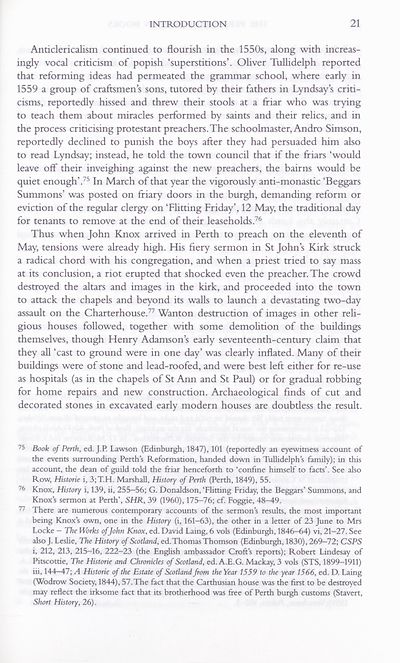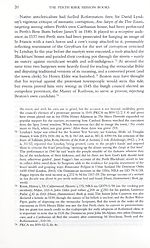Series 6 > Perth Kirk Session books, 1577-1590
(36) Page 21
Download files
Complete book:
Individual page:
Thumbnail gallery: Grid view | List view

INTRODUCTION
21
Anticlericalism continued to flourish in the 1550s, along with increas¬
ingly vocal criticism of popish ‘superstitions’. Oliver Tullidelph reported
that reforming ideas had permeated the grammar school, where early in
1559 a group of craftsmen’s sons, tutored by their fathers in Lyndsay’s criti¬
cisms, reportedly hissed and threw their stools at a friar who was trying
to teach them about miracles performed by saints and their relics, and in
the process criticising protestant preachers. The schoolmaster, Andro Simson,
reportedly dechned to punish the boys after they had persuaded him also
to read Lyndsay; instead, he told the town council that if the friars ‘would
leave off their inveighing against the new preachers, the bairns would be
quiet enough’.75 In March of that year the vigorously anti-monastic ‘Beggars
Summons’ was posted on friary doors in the burgh, demanding reform or
eviction of the regular clergy on ‘Flitting Friday’, 12 May, the traditional day
for tenants to remove at the end of their leaseholds.76
Thus when John Knox arrived in Perth to preach on the eleventh of
May, tensions were already high. His fiery sermon in St John’s Kirk struck
a radical chord with his congregation, and when a priest tried to say mass
at its conclusion, a riot erupted that shocked even the preacher. The crowd
destroyed the altars and images in the kirk, and proceeded into the town
to attack the chapels and beyond its walls to launch a devastating two-day
assault on the Charterhouse.77 Wanton destruction of images in other reli¬
gious houses followed, together with some demolition of the buildings
themselves, though Henry Adamson’s early seventeenth-century claim that
they all ‘cast to ground were in one day’ was clearly inflated. Many of their
buildings were of stone and lead-roofed, and were best left either for re-use
as hospitals (as in the chapels of St Ann and St Paul) or for gradual robbing
for home repairs and new construction. Archaeological finds of cut and
decorated stones in excavated early modern houses are doubdess the result.
75 Book of Perth, ed. J.P. Lawson (Edinburgh, 1847), 101 (reportedly an eyewitness account of
the events surrounding Perth’s Reformation, handed down in Tullidelph’s family); in this
account, the dean of guild told the friar henceforth to ‘confine himself to facts’. See also
Row, Historic i, 3;T.H. Marshall, History of Perth (Perth, 1849), 55.
76 Knox, History i, 139, ii, 255-56; G. Donaldson, ‘Flitting Friday, the Beggars’ Summons, and
Knox’s sermon at Perth’, SHR, 39 (1960), 175-76; cf. Foggie, 48-49.
77 There are numerous contemporary accounts of the sermon’s results, the most important
being Knox’s own, one in the History (i, 161-63), the other in a letter of 23 June to Mrs
Locke - The Works of John Knox, ed. David Laing, 6 vols (Edinburgh, 1846-64) vi, 21-27. See
also J. Leshe, The History of Scotland, ed. Thomas Thomson (Edinburgh, 1830), 269-72; CSPS
i, 212, 213, 215-16, 222—23 (the English ambassador Croft’s reports); Robert Lindesay of
Pitscottie, The Historic and Chronicles of Scotland, ed. A.E.G. Mackay, 3 vols (STS, 1899-1911)
iii, 144—47; A Historic of the Estate of Scotland from the Year 1559 to the year 1566, ed. D. Laing
(Wodrow Society, 1844), 57.The fact that the Carthusian house was the first to be destroyed
may reflect the irksome fact that its brotherhood was free of Perth burgh customs (Stavert,
Short History, 26).
21
Anticlericalism continued to flourish in the 1550s, along with increas¬
ingly vocal criticism of popish ‘superstitions’. Oliver Tullidelph reported
that reforming ideas had permeated the grammar school, where early in
1559 a group of craftsmen’s sons, tutored by their fathers in Lyndsay’s criti¬
cisms, reportedly hissed and threw their stools at a friar who was trying
to teach them about miracles performed by saints and their relics, and in
the process criticising protestant preachers. The schoolmaster, Andro Simson,
reportedly dechned to punish the boys after they had persuaded him also
to read Lyndsay; instead, he told the town council that if the friars ‘would
leave off their inveighing against the new preachers, the bairns would be
quiet enough’.75 In March of that year the vigorously anti-monastic ‘Beggars
Summons’ was posted on friary doors in the burgh, demanding reform or
eviction of the regular clergy on ‘Flitting Friday’, 12 May, the traditional day
for tenants to remove at the end of their leaseholds.76
Thus when John Knox arrived in Perth to preach on the eleventh of
May, tensions were already high. His fiery sermon in St John’s Kirk struck
a radical chord with his congregation, and when a priest tried to say mass
at its conclusion, a riot erupted that shocked even the preacher. The crowd
destroyed the altars and images in the kirk, and proceeded into the town
to attack the chapels and beyond its walls to launch a devastating two-day
assault on the Charterhouse.77 Wanton destruction of images in other reli¬
gious houses followed, together with some demolition of the buildings
themselves, though Henry Adamson’s early seventeenth-century claim that
they all ‘cast to ground were in one day’ was clearly inflated. Many of their
buildings were of stone and lead-roofed, and were best left either for re-use
as hospitals (as in the chapels of St Ann and St Paul) or for gradual robbing
for home repairs and new construction. Archaeological finds of cut and
decorated stones in excavated early modern houses are doubdess the result.
75 Book of Perth, ed. J.P. Lawson (Edinburgh, 1847), 101 (reportedly an eyewitness account of
the events surrounding Perth’s Reformation, handed down in Tullidelph’s family); in this
account, the dean of guild told the friar henceforth to ‘confine himself to facts’. See also
Row, Historic i, 3;T.H. Marshall, History of Perth (Perth, 1849), 55.
76 Knox, History i, 139, ii, 255-56; G. Donaldson, ‘Flitting Friday, the Beggars’ Summons, and
Knox’s sermon at Perth’, SHR, 39 (1960), 175-76; cf. Foggie, 48-49.
77 There are numerous contemporary accounts of the sermon’s results, the most important
being Knox’s own, one in the History (i, 161-63), the other in a letter of 23 June to Mrs
Locke - The Works of John Knox, ed. David Laing, 6 vols (Edinburgh, 1846-64) vi, 21-27. See
also J. Leshe, The History of Scotland, ed. Thomas Thomson (Edinburgh, 1830), 269-72; CSPS
i, 212, 213, 215-16, 222—23 (the English ambassador Croft’s reports); Robert Lindesay of
Pitscottie, The Historic and Chronicles of Scotland, ed. A.E.G. Mackay, 3 vols (STS, 1899-1911)
iii, 144—47; A Historic of the Estate of Scotland from the Year 1559 to the year 1566, ed. D. Laing
(Wodrow Society, 1844), 57.The fact that the Carthusian house was the first to be destroyed
may reflect the irksome fact that its brotherhood was free of Perth burgh customs (Stavert,
Short History, 26).
Set display mode to:
![]() Universal Viewer |
Universal Viewer | ![]() Mirador |
Large image | Transcription
Mirador |
Large image | Transcription
Images and transcriptions on this page, including medium image downloads, may be used under the Creative Commons Attribution 4.0 International Licence unless otherwise stated. ![]()
| Scottish History Society volumes > Series 6 > Perth Kirk Session books, 1577-1590 > (36) Page 21 |
|---|
| Permanent URL | https://digital.nls.uk/127281069 |
|---|
| Description | Over 180 volumes, published by the Scottish History Society, containing original sources on Scotland's history and people. With a wide range of subjects, the books collectively cover all periods from the 12th to 20th centuries, and reflect changing trends in Scottish history. Sources are accompanied by scholarly interpretation, references and bibliographies. Volumes are usually published annually, and more digitised volumes will be added as they become available. |
|---|


